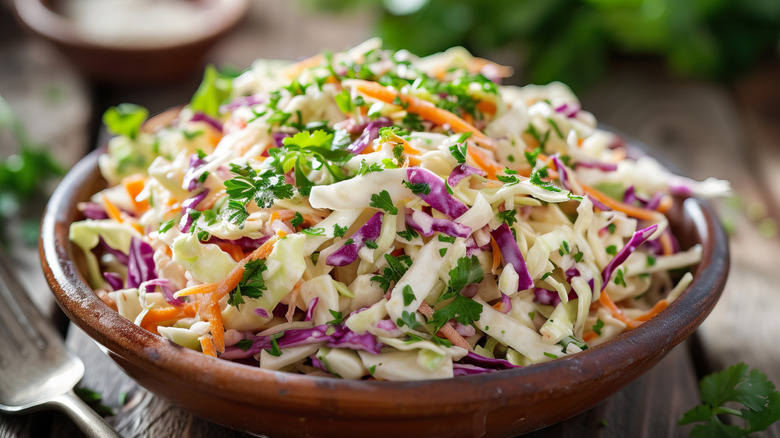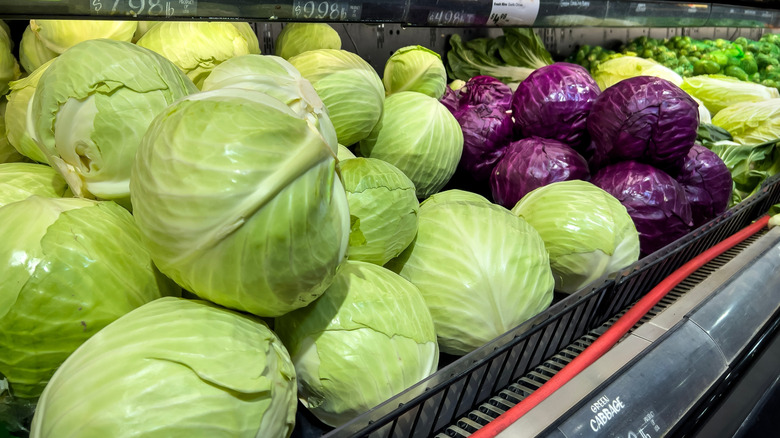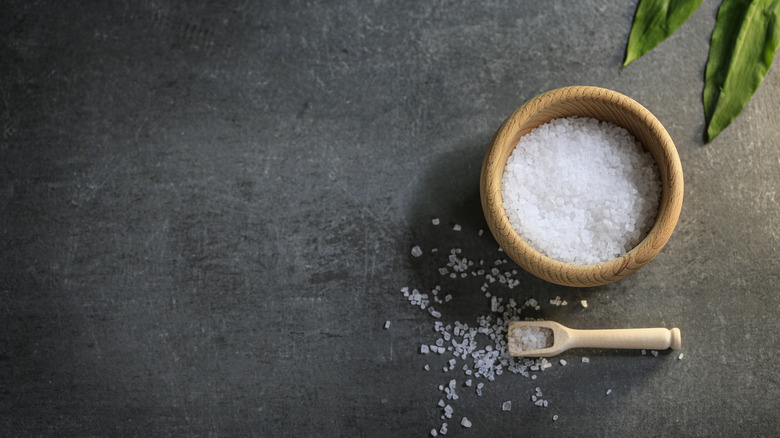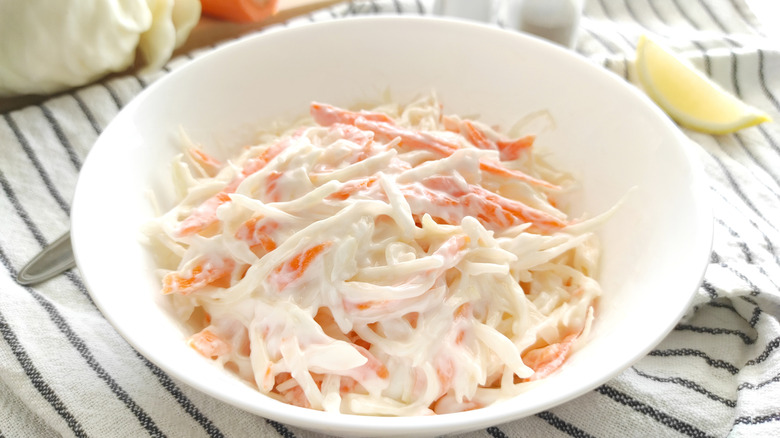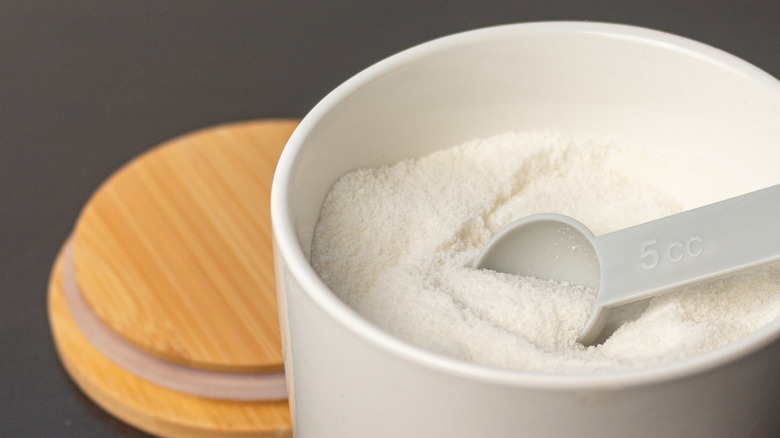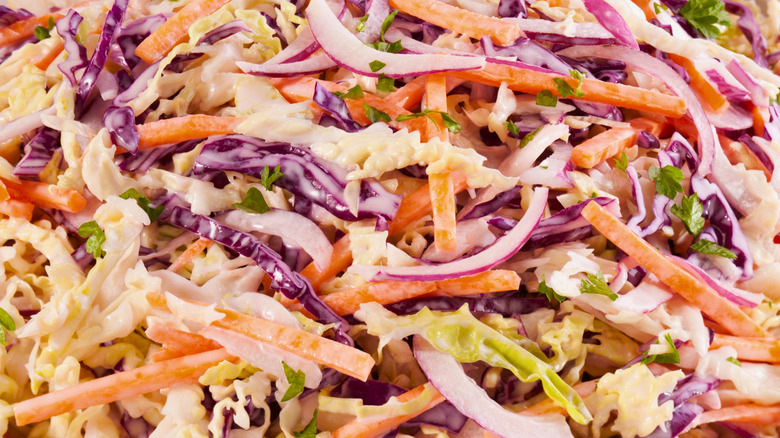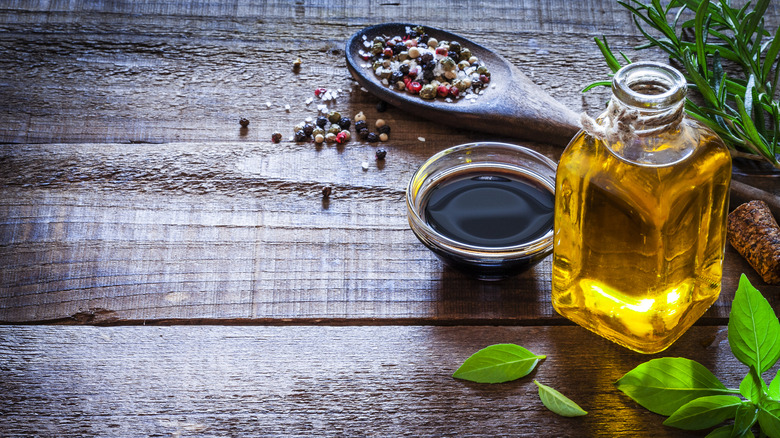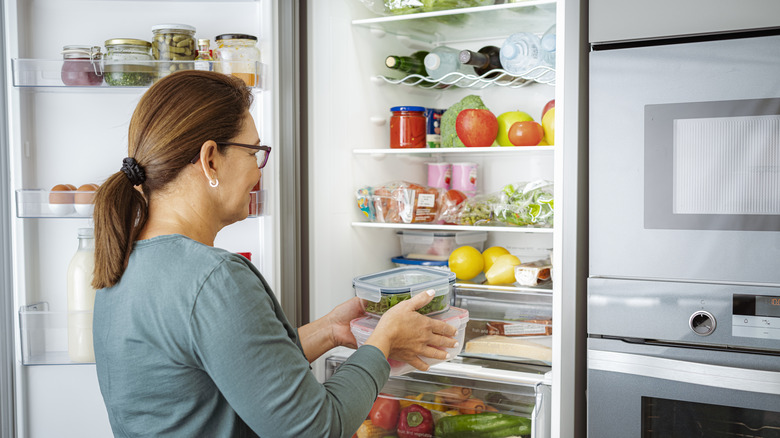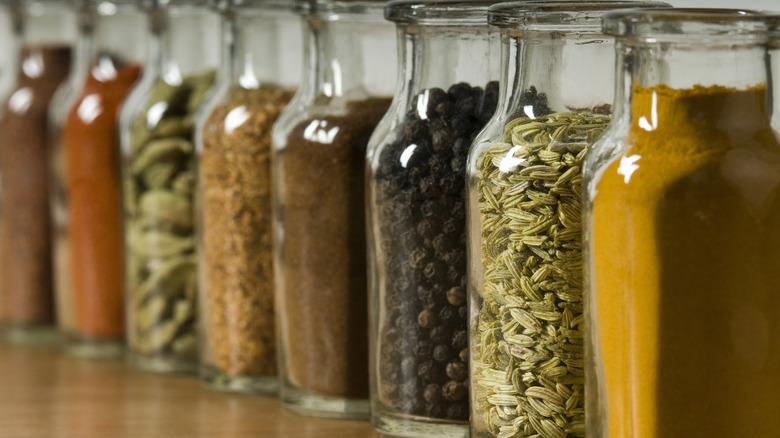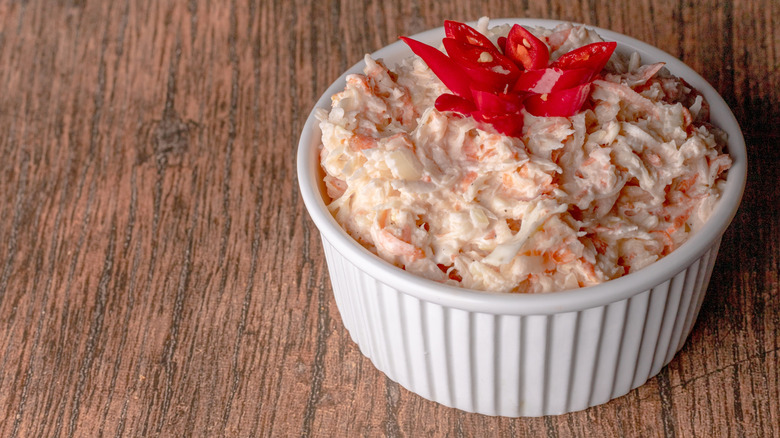3 Chefs Lay Out The Big Mistakes That Are Ruining Your Coleslaw
You invited the guests, mastered all your barbecue grilling hacks, and are almost ready for your backyard cookout. The only thing that stands in the way of pulling it off is that coleslaw recipe. Because is any cookout or party really complete without coleslaw? While you may think that preparing coleslaw is a no-brainer and something you don't have to think about until the last minute, you'd unfortunately be mistaken.
There are several mistakes that people commonly make when preparing coleslaw. And, while these mistakes may seem little, they can have a disastrous impact on the finished recipe. Think soggy or runny coleslaw, a mix that simply lacks any flavor or a finished product that is so acidic it causes a burning sensation in your throat or mouth as you eat it. Don't get caught up by these mistakes the next time you make coleslaw. Instead, follow the advice of the three expert chefs who helped us learn about the mistakes that plague people as they try to make coleslaw. Sean Thompson is the executive chef at Porter House Bar & Grill. Galen Zamarra is the co-founder of Galen Hospitality Group, and Jessie-Sierra Ross is a TV food content creator on NBC, CBS, and PBS, a cookbook author of "Seasons Around the Table," and runs Straight to the Hips, Baby, a food and lifestyle blog.
1. Using the wrong type of cabbage
Did you know that there are different varieties of cabbage and that some are better suited for coleslaw than others? If you grab any head of cabbage you see at the store when preparing to make coleslaw, you've just committed your first mistake. Jessie-Sierra Ross explains that cabbage's "flavor can range from a pleasant 'green' taste to downright bitter. Choosing the right type of cabbage that can also structurally hold up to the dressing AND taste amazing is key."
Ross recommends varieties such as red cabbage, Savoy cabbage, or green cabbage. She explains that any of these varieties will deliver when it comes to both flavor (and perfectly complementing your dressing) and crunch. "I typically avoid using Napa Cabbage, not because of the taste, but because of its fragile structure. I find it tends to wilt in the bowl after a bit," she shares.
2. Failing to cut the veggies into evenly-sized pieces
According to Galen Zamarra, failing to make even cuts for your veggies when preparing coleslaw can be problematic for several reasons. First, as Zamarra reminds us, "We eat visually first (with our eyes before our mouths), so the appearance is an important first step in making people excited about something." Even if something tastes incredible, the experience of eating it isn't going to be as enjoyable if it looks sloppy or weird.
Even more important is that unevenly chopped vegetables will lead to a coleslaw that doesn't have an even and uniform flavor. "The thickness determines how soft it gets, how quickly and thoroughly the dressing seasons it. If this is uneven, some bites will be soggy and some crunchy, some over-seasoned and some under-seasoned or dressed," explains Zamarra. Taking the time and care to chop your veggies evenly for your coleslaw will pay off. If you find yourself rushing with onions so you don't tear up, don't forget that a wet paper towel is the key to cutting onions without crying, as it absorbs some of the tear-inducing chemicals.
3. Not salting the cabbage before mixing ingredients
Salt plays such a crucial role in so many recipes. In addition to acting as a flavor enhancer, salt can help draw out moisture from certain food items. For example, you may have heard that you should salt apple slices before baking to release excess liquid before putting them in your pie filling or other recipes. Well, making coleslaw is no different: Salt will be your friend. According to Jessie-Sierra Ross, you want to use the salt on the cabbage before mixing it with the dressing. This will avoid causing any issues with the crunchiness of the cabbage.
Instead, when you salt the cabbage leaves once they're sliced, you can purge the cabbage. Ross explains, "Salt purging draws out some of the excess moisture in the cabbage leaves and intensifies the flavor (similar in technique to brining a chicken or turkey before roasting)." She recommends putting the cabbage in a colander in the sink for about an hour to let it release as much excess moisture as possible. Then, after rinsing the excess salt off and gently squeezing it to remove more water, she says, "Spread the cabbage out to dry on some paper towels or a clean tea towel until use."
4. Adding too much dressing
Dressing is an essential component of any coleslaw. However, that doesn't mean you should dump a ton on the cabbage and other veggies and call it a day. Just as there are dressing mistakes you want to avoid when preparing pasta salad, you also don't want to make the mistake of adding too much dressing to your coleslaw. Both Sean Thomson and Galen Zamarra explain different ways that using too much dressing can ruin your coleslaw. Thompson states, "Adding too much dressing can overwhelm the veggies and mask their flavor." Instead, he says you should "use just enough to coat the veggies lightly, so they stay crisp and flavorful."
Zamarra points out another problem when you're too heavy-handed with the dressing. He notes, "The salt, sugar, and acid (lemon/ vinegar) will draw out the natural moisture of the vegetables. So as the slaw sits, it will loosen up the dressing, making it more liquidy." The longer the coleslaw sits in the dressing, the soupier it is going to get. And, when you combine the extra liquid from the moisture that is pulled out of the veggies with excess dressing, you can quickly see the problem you will be facing.
5. Not adding the right amount of sugar
While you might not think of coleslaw as a "sweet" treat, sugar is an important ingredient to add to your mix. Sean Thompson explains, "Skipping or using too little sugar can make the coleslaw taste too tart or bland." Cabbage is very bitter, and the dressing can be acidic, so the right amount of sugar will help provide the right balance for a palate-pleasing finished product.
However, you don't want to add so much sugar that your coleslaw tastes more like a dessert than a side dish. Thompson says, "Add enough sugar to balance out the acidity and enhance the overall flavor." So, how much is this, exactly? Well, that can vary based on the type of cabbage you use, the dressing recipe, and your taste preferences. You'll probably want to use somewhere between 1 and 3 tablespoons of sugar for your dressing. You can also sprinkle some sugar (along with the salt) over your cabbage leaves when you purge them of any excess moisture. Like salt, sugar also facilitates osmosis- the process of releasing water.
6. Not adding a variety of veggies
Cabbage is an essential ingredient when preparing coleslaw. But, if it is the only veggie you use, you aren't going to end up with coleslaw. Rather, you'll just have some cabbage covered with dressing. As Sean Thompson explains, "Missing key ingredients or not using enough can make your coleslaw taste plain. Make sure to include a variety of veggies and seasonings to keep it interesting."
Jessie-Sierra Ross highlights a few of these additional elements that you can add to your mix. She notes that "shredded carrots, julienned red bell peppers, or even thin strips of green scallion can really perk [the coleslaw] up." When choosing which veggies to add, follow Ross' advice to pick ones that are at the peak of freshness to ensure the best tasting finished product. For a more unique flavor. Slice them at the same time you're cutting the cabbage to ensure everything is fresh and ready to enjoy.
7. Not striking the right balance between acidic and fatty ingredients
As Jessie-Sierra Ross explains, "Coleslaw typically uses some sort of vinegar to add tartness and taste." Without vinegar, coleslaw just isn't going to taste right. You can use different types of vinegar to help you achieve that classic tart flavor. Ross recommends apple cider vinegar for those looking for a slightly fruitier option or red wine vinegar for those who want coleslaw to pack more of a punch.
However, Ross cautions against adding too much vinegar when preparing the dressing for your coleslaw. Vinegar is very acidic, and when you add too much to your slaw, it can also become overly acidic, potentially causing discomfort to those who eat it. To avoid this issue, Ross says, "Make sure to balance your flavors by adding some fat to the dressing, like olive oil or a little mayonnaise. You can also counterbalance the vinegar taste with something sweet, like sugar or honey."
8. Not letting the dressing rest in the fridge
Coleslaw may be a relatively simple dish to prepare. However, it is not one you should wait until the last second to make before a gathering. One reason is that you need to give the dressing time to rest before mixing it with the other ingredients in the bowl. Jessie-Sierra Ross explains why this rest time is so crucial. She says, "The time in the chiller allows the flavors to meld."
Beyond enhancing the flavors in the dressing itself, letting the dressing rest before mixing it with the cabbage serves another important purpose. Ross explains that it also "ensures that the shredded cabbage won't get wilty." If the dressing sits on the leaves for too long, they'll start to shrivel. Refrigerating the dressing by itself first helps keep the potential of wilting to a minimum.
9. Not seasoning the slaw properly
How you season your coleslaw can also make or break the finished side dish. "Coleslaw can get over-seasoned very quickly," cautions Jessie-Sierra Ross. She recommends going very slowly when adding seasonings to your bowl. Remember, you can always add more seasonings and spices, but you won't be able to take any off once they've been mixed with the cabbage and dressing.
As for what to season the slaw with, well, that will vary based on the specific flavor profile you're looking to achieve. "Freshly ground black pepper, smoked paprika, celery seeds, and even Dijon mustard make excellent seasoning additions." Sometimes, you might go too far, though, and after tasting it, you may think a restart is required. But think again; all is not lost. Ross advises, "If the dressing is starting to veer off a bit, bring it back with an extra dollop of mayo and a squeeze of honey."
10. Not chilling your coleslaw for the right amount of time
Failing to keep your coleslaw cold is a food safety mistake that can ruin your summer barbecues. It uses perishable ingredients that can make people sick if left out at room temperature (or even warmer outdoor temperatures) for too long. Make sure you don't leave coleslaw out of the fridge for more than two hours — or more than one hour if outdoor temperatures exceed 90 degrees Fahrenheit.
Beyond the safety reasons of keeping coleslaw cold, chilling it will also help it taste better. Galen Zamarra says, "It is important to let the slaw sit with the dressing to soften the cabbage and let the seasoning penetrate and do its thing. This should be done refrigerated. Coleslaw also tastes much better when cold." Sean Thompson highlights the importance of striking the balance for the ideal chill time. He says, "If it sits for too long, it can become too soft; if not long enough, the flavors might not fully develop." He recommends letting your coleslaw chill for an hour or so. If you're bringing the coleslaw as a side to a gathering at a friend's house, you can try the ice tray hack to freeze large foil pans filled with water to keep it cold during transport.
